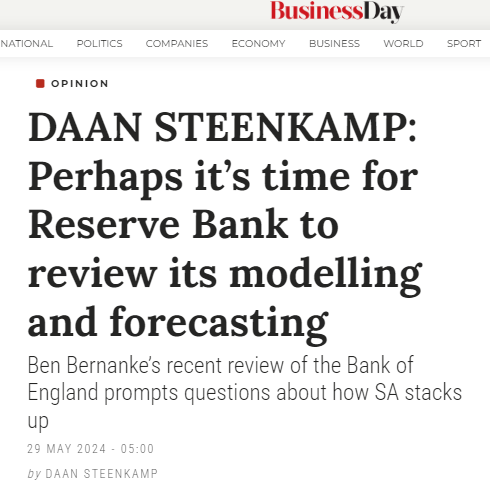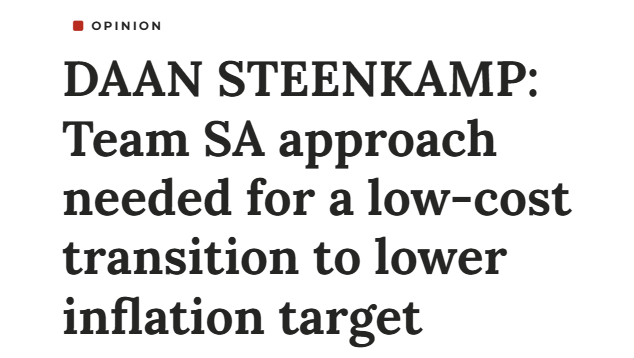The IMF assessment of South African Reserve Bank (SARB)’s transparency was released yesterday. Overall, it is a favourable review noting that ‘the SARB sets a high benchmark for transparency’. The IMF praises SARB, for example, for engaging a wide range of stakeholders via different forums and
platforms and for the approach it followed to implementation of the new new tiered-floor system for monetary policy operations. Today’s post provides a list of noteworthy recommendations from the 121 page report.
With respect to financial surveillance:
- ‘consider publishing an overview of its Anti-Money Laundering and Combating the Financing of Terrorism (AML/CFT) supervisory policies’
- ‘Proactively disclose information on the SARB’s AML/CFT supervisory policies and resources—and on the remedial actions taken by supervised institutions’
With respect to financial market operations:
- ‘The transparency of the FX reserve management framework would benefit from the disclosure of nonmarket sensitive components of the internal investment guideline or of key macrofinancial features of South Africa that have a bearing on the design of the guideline (i.e., adequacy and liquidity parameters), as well as the inputs provided by the NT in the context of the periodic updates. Furthermore, regarding FX reserve adequacy, transparency in the implementation of the GFECRA framework would greatly benefit from the disclosure of detailed (not market sensitive) information on the calculation of the level of adequate FX reserves and updates as the need arises. Finally, more frequent publication of the currency composition of the official FX reserves (than the current one year periodicity) would also enhance transparency.’
- ‘establishing a clear communication strategy around the GFECRA, disclosing its features; the reform timelines, given the potential impact on the money market; establishing a dedicated page on the SARB’s website; and reaching out to relevant stakeholders through seminars and workshops’
With respect to financial stability:
- ‘disclose information on the Financial Stability Committee, and to provide more detailed information on the tasks and outcomes of FSOC and FSCF meetings as well as its consultations with other relevant authorities for financial stability, while keeping sensitive information confidential.’
- ‘Recognizing that few analytical papers have been published, the SARB’s transparency practice could be strengthened by publishing ex post evaluations of whether the implemented measures have achieved the intended effects.’
- ‘If and when it is developed, market participants would benefit from the disclosure of a framework for handling systemic markets dysfunction.’
With respect to communication:
- ‘improving the website’s accessibility’
- ‘The SARB’s website describes the SARB’s functions but lacks clarity on the legal foundation that undergirds those functions. Further, while the SARB’s powers are listed in the SARB Act, the SARB’s website does not discuss those powers, even in general terms, let alone how they are linked to the SARB’s functions and prohibited activities.’
With respect to the inflation target:
- ‘the process for setting the target is opaque and not well understood by external stakeholders. This lack of transparency has created uncertainty around the respective roles of the NT and the SARB in reviewing and setting the inflation target and the interpretation of the target range.’
- ‘more clarity is advised with respect to the review of the SARB’s monetary policy framework and the setting of the inflation target by the NT in consultation with the SARB’
With respect to monetary policy:
- ‘improve monetary policy transparency by providing more information on dissenting votes in the Monetary Policy Committee (MPC) deliberations, by including alternative risk scenarios in the Monetary Policy Review (MPR) and by clarifying the ownership of various communication vehicles’
- ‘The ownership of, and accountability for, the various monetary publications and included forecasts could be improved. The Monetary Policy Statements are released by the Governor’s office, not by the MPC, the decision-making body. The MPRs do not have a preface that confirms MPC ownership and accountability for the document and the included projections. Some external stakeholders said it was not clear to whom the forecasts should be attributed—the MPC or the staff.’
- ‘The SARB regularly conducts an ex-post evaluation of its inflation and output forecasts, but it does not systemically conduct transparent post-mortems of its monetary policy framework and its implementation.’
For our take on how SARB can improve its monetary policy transparency, see these two ungated Business Day articles (here and here).

